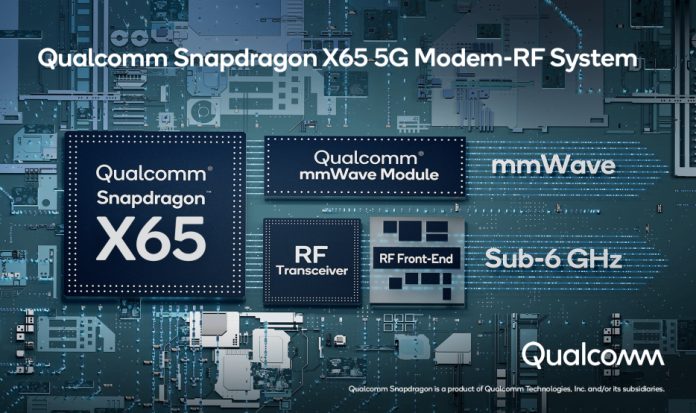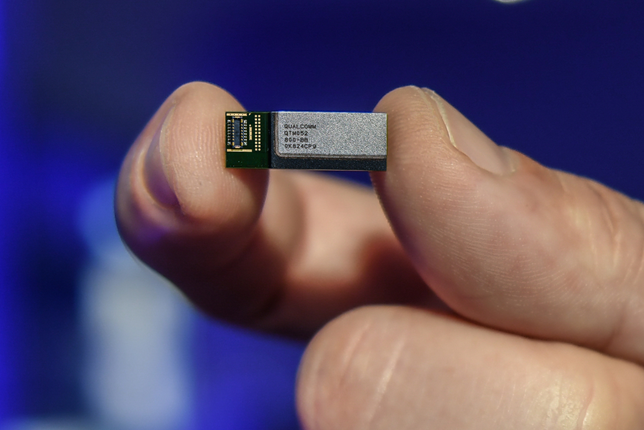Early 5G implementations began at the end of 2019, and since then, RF front-end (RFFE) designs have come a long way in terms of higher integration and support for multimode operation ranging from 5G to 2G radios.
For instance, data converters in these RFFEs now support the channel bandwidths available in millimeter-wave (mmWave) bands. That, in turn, will open the doors for the generalization of RF architectures and potentially reduce RF circuitry’s complexity by moving the digital-analog divide closer to the antenna.
RFFEs are also known as front-end modules. These parts use smart partitioning architectures to integrate high-speed amplifiers, receive analog-to-digital converters, and transmit path digital-to-analog converters along with ever-shrinking high-frequency filter designs. Integration is the name of the game in 5G radio designs, as discrete RF solutions no longer suffice.
Take Qualcomm’s RFFE designs that integrate several RF components between modem and antenna. These modem-to-antenna solutions bring together modem, RF transceiver, RF front-end components, and antenna modules, thus enabling mobile OEMs to quickly commercialize devices with support for new frequency bands such as n53, n70, and n259 in the 41-GHz band.
One of the latest examples is the Snapdragon X65 5G modem-RF system, Qualcomm’s fourth-generation 5G modem-to-antenna solution. The Snapdragon X65 supports spectrum aggregation of up to 1 GHz in the mmWave spectrum and 300 MHz of sub-6-GHz spectrum.

The X65 is a fourth-generation 5G modem-to-antenna solution that features antenna tuning and spectrum aggregation capabilities. (Source: Qualcomm)
Then there are ADRF554x RF front ends for massive MIMO (M-MIMO) radios from Analog Devices Inc. These RFFEs vastly increase the number of simultaneous transceiver channels operating in multiple bands while squeezing all the necessary hardware into a smaller form factor.
The ADRF554x family of RF front ends incorporates a high-power switch in silicon process and a high-performance low-noise amplifier in GaAs process. These RF front ends, which cover cellular bands from 1.8 GHz to 5.3 GHz, are optimally designed for M-MIMO antenna interfaces.
As a result, with a higher number of antennas and bands that need to be supported and a large number of components necessary to achieve adequate coverage, we see an unprecedented complexity in the RF realm. So in the early going, the rising complexity of 5G radios limited the number of manufacturers with the expertise to develop such complex RF subsystems. However, more suppliers are now stepping up to the RFFE challenge as 5G designs mature.
RF front-end design challenges
RF design represents a huge opportunity in 5G networks amid the deployment of a vast number of base stations in mini-, micro-, pico-, and femto-cell environments, as well as new terminal devices for the internet-of-things and industrial IoT applications. That’s likely to add a massive growth in connected devices for highly diverse use cases and requirements.
Spectral efficiency and reuse, higher speeds, and lower latency are major considerations for RFFE designs to meet this massive boost in wireless data traffic capacity. First and foremost, spectral efficiency is vital because mmWave frequencies, the spectrum above 6 GHz, have drawn a great deal of attention for an extensive bandwidth availability.
However, transmission in the mmWave band is most challenging in outdoor areas, and the task of an RFFE design is to improve high path loss, high oxygen and H2O absorption, losses through the foliage, and fading due to rain. So RF designers are employing beamforming and beam-tracking technologies to overcome unfavorable channel characteristics in the mmWave frequency.
Second, speed is crucial in RFFE designs because 5G radio architectures operate at much higher data rates than prior 2G, 3G, and 4G systems. The present 5G systems are 10× faster than 4G LTE radios.
Third, latency is the new element, along with faster access in 5G designs. It’s far more important in 5G RFFEs than in previous 3G and 4G versions. 5G has a minimum latency of 1 ms or less. On the other hand, in 4G systems, latency is at 50 ms to 98 ms, in 3G systems at 212 ms, and in 2G systems at a whopping 629 ms. The new 5G services are now employing the ultra-reliable low-latency communication feature to manage latency-related issues.

Highly integrated RFFE solutions, like the Qualcomm X55 5G Modem-RF System, that support any combination of frequency bands and modes allow engineers to focus on industrial design and the user interface, thus delivering better products in a shorter time and at a lower cost. (Source: Qualcomm)
The synopsis of RFFE issues in 5G designs shows the disruptive nature of RF technologies. Especially, when RF sampling is getting closer to the antenna, which, in turn, will simplify and shrink radio form factors and enable higher levels of integration. So at this technology crossroads, what’s the industry doing to facilitate greater levels of integration while keeping design complexity in check? The following section takes a closer look at an RF industry initiative.
OpenRF consortium
The recently established Open RF Association (OpenRF) aims to create functional interoperability of hardware and software across multimode RF front ends in 5G designs. This open framework will standardize hardware and software interfaces while still allowing design innovation among RF solution suppliers. The consortium’s founding members include Broadcom, Intel, MediaTek, Murata, Qorvo, and Samsung.
According to Joe Madden, principal analyst at Mobile Experts, the mobile industry increasingly needs structure to deal with the complexity, which is now a hallmark of RF front-end designs. “OpenRF will standardize building blocks in non-competitive areas and thus allow RFFE vendors to focus their efforts on the sharp point of innovation,” he said.
It is worth noting that the MIPI RFFE specification defining the control interface of the RF front end will continue to be developed within the MIPI Alliance’s RFFE Working Group. Moreover, OpenRF is currently working on a liaison agreement with the MIPI Alliance.
The above outline of RF front-end design challenges, solutions, and industry initiatives for 5G handset and infrastructure applications is a testament to a hyper integration drive that brings RFFE modularization ever closer to reality. Furthermore, while RF front ends are packing components essential in routing, filtering, and amplifying signals to and from the antennas, these highly integrated designs will directly impact the device’s power consumption. That’s critical in 5G device designs offering all-day battery life.
Advertisement
Learn more about Analog DevicesQualcomm





